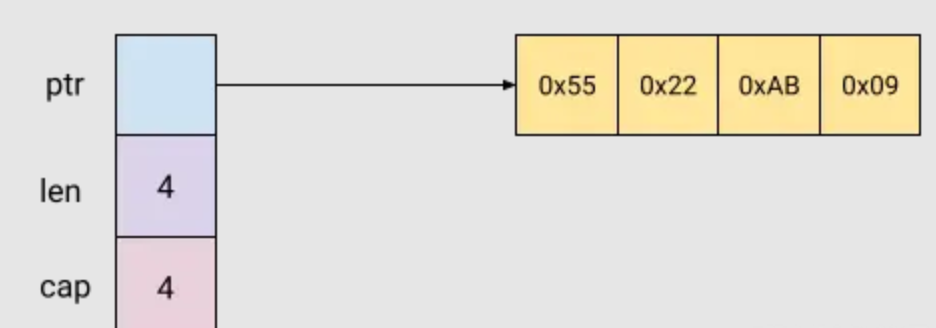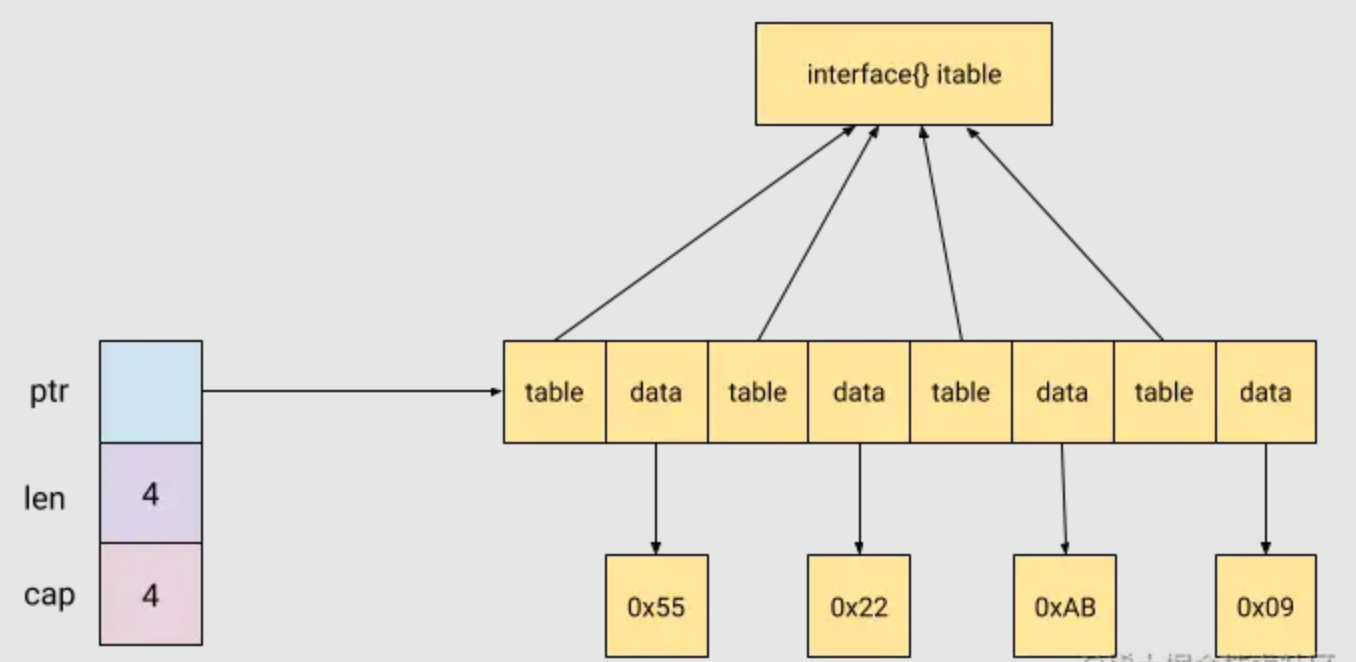中国企业500强净利润排名网站关键词优化教程
文章目录
- 前言
- 官方解释
- 内存布局
- 程序运行中的内存布局
- 通用方法
前言
在 Go 中,如果 interface{} 作为函数参数的话,是可以传任意参数的,然后通过类型断言来转换。
举个例子:
package mainimport "fmt"func foo(v interface{}) {if v1, ok1 := v.(string); ok1 {fmt.Println(v1)} else if v2, ok2 := v.(int); ok2 {fmt.Println(v2)}
}func main() {foo(233)foo("666")
}
不管是传 int 还是 string,最终都能输出正确结果。
那么,既然是这样的话,我就有一个疑问了,拿出我举一反三的能力。是否可以将 []T 转换为 []interface 呢?
比如下面这段代码:
func foo([]interface{}) { /* do something */ }func main() {var a []string = []string{"hello", "world"}foo(a)
}
很遗憾,这段代码是不能编译通过的,如果想直接通过 b := []interface{}(a) 的方式来转换,还是会报错:
cannot use a (type []string) as type []interface {} in function argument
正确的转换方式需要这样写:
b := make([]interface{}, len(a), len(a))
for i := range a {b[i] = a[i]
}
本来一行代码就能搞定的事情,却非要让人写四行,是不是感觉很麻烦?那为什么 Go 不支持呢?我们接着往下看。
官方解释
这个问题在官方 Wiki 中是有回答的,我复制出来放在下面:
The first is that a variable with type []interface{} is not an interface! It is a slice whose element type happens to be interface{}. But even given this, one might say that the meaning is clear.
Well, is it? A variable with type []interface{} has a specific memory layout, known at compile time.
Each interface{} takes up two words (one word for the type of what is contained, the other word for either the contained data or a pointer to it). As a consequence, a slice with length N and with type []interface{} is backed by a chunk of data that is N2 words long.
This is different than the chunk of data backing a slice with type []MyType and the same length. Its chunk of data will be Nsizeof(MyType) words long.
The result is that you cannot quickly assign something of type []MyType to something of type []interface{}; the data behind them just look different.
大概意思就是说,主要有两方面原因:
- []interface{} 类型并不是 interface,它是一个切片,只不过碰巧它的元素是 interface;
- []interface{} 是有特殊内存布局的,跟 interface 不一样。
下面就来详细说说,是怎么个不一样。
内存布局
首先来看看 slice 在内存中是如何存储的。在源码中,它是这样定义的:
// src/runtime/slice.gotype slice struct {array unsafe.Pointerlen intcap int
}
- array 是指向底层数组的指针;
- len 是切片的长度;
- cap 是切片的容量,也就是 array 数组的大小。
举个例子,创建如下一个切片:
is := []int64{0x55, 0x22, 0xab, 0x9}
那么它的布局如下图所示:

假设程序运行在 64 位的机器上,那么每个「正方形」所占空间是 8 bytes。上图中的 ptr 所指向的底层数组占用空间就是 4 个「正方形」,也就是 32 bytes。
接下来再看看 []interface{} 在内存中是什么样的。
回答这个问题之前先看一下 interface{} 的结构,Go 中的接口类型分成两类:
- iface 表示包含方法的接口;
- eface 表示不包含方法的空接口。
源码中的定义分别如下:
type iface struct {tab *itabdata unsafe.Pointer
}
type eface struct {_type *_typedata unsafe.Pointer
}
具体细节我们不去深究,但可以明确的是,每个 interface{} 包含两个指针, 会占据两个「正方形」。第一个指针指向 itab 或者 _type;第二个指针指向实际的数据。
所以它在内存中的布局如下图所示:

因此,不能直接将 []int64 直接传给 []interface{}。
程序运行中的内存布局
接下来换一个更形象的方式,从程序实际运行过程中,看看内存的分布是怎么样的?
看下面这样一段代码:
package mainvar sum int64func addUpDirect(s []int64) {for i := 0; i < len(s); i++ {sum += s[i]}
}func addUpViaInterface(s []interface{}) {for i := 0; i < len(s); i++ {sum += s[i].(int64)}
}func main() {is := []int64{0x55, 0x22, 0xab, 0x9}addUpDirect(is)iis := make([]interface{}, len(is))for i := 0; i < len(is); i++ {iis[i] = is[i]}addUpViaInterface(iis)
}
我们使用 Delve 来进行调试,可以点击这里进行安装。
dlv debug slice-layout.go
Type 'help' for list of commands.
(dlv) break slice-layout.go:27
Breakpoint 1 set at 0x105a3fe for main.main() ./slice-layout.go:27
(dlv) c
> main.main() ./slice-layout.go:27 (hits goroutine(1):1 total:1) (PC: 0x105a3fe)22: iis := make([]interface{}, len(is))23: for i := 0; i < len(is); i++ {24: iis[i] = is[i]25: }26:
=> 27: addUpViaInterface(iis)28: }
打印 is 的地址:
(dlv) p &is
(*[]int64)(0xc00003a740)
接下来看看 slice 在内存中都包含了哪些内容:
(dlv) x -fmt hex -len 32 0xc00003a740
0xc00003a740: 0x10 0xa7 0x03 0x00 0xc0 0x00 0x00 0x00
0xc00003a748: 0x04 0x00 0x00 0x00 0x00 0x00 0x00 0x00
0xc00003a750: 0x04 0x00 0x00 0x00 0x00 0x00 0x00 0x00
0xc00003a758: 0x00 0x00 0x09 0x00 0xc0 0x00 0x00 0x00
每行有 8 个字节,也就是上文说的一个「正方形」。第一行是指向数据的地址;第二行是 4,表示切片长度;第三行也是 4,表示切片容量。
再来看看指向的数据到底是怎么存的:
(dlv) x -fmt hex -len 32 0xc00003a710
0xc00003a710: 0x55 0x00 0x00 0x00 0x00 0x00 0x00 0x00
0xc00003a718: 0x22 0x00 0x00 0x00 0x00 0x00 0x00 0x00
0xc00003a720: 0xab 0x00 0x00 0x00 0x00 0x00 0x00 0x00
0xc00003a728: 0x09 0x00 0x00 0x00 0x00 0x00 0x00 0x00
这就是一片连续的存储空间,保存着实际数据。
接下来用同样的方式,再来看看 iis 的内存布局。
(dlv) p &iis
(*[]interface {})(0xc00003a758)
(dlv) x -fmt hex -len 32 0xc00003a758
0xc00003a758: 0x00 0x00 0x09 0x00 0xc0 0x00 0x00 0x00
0xc00003a760: 0x04 0x00 0x00 0x00 0x00 0x00 0x00 0x00
0xc00003a768: 0x04 0x00 0x00 0x00 0x00 0x00 0x00 0x00
0xc00003a770: 0xd0 0xa7 0x03 0x00 0xc0 0x00 0x00 0x00
切片的布局和 is 是一样的,主要的不同是所指向的数据:
(dlv) x -fmt hex -len 64 0xc000090000
0xc000090000: 0x00 0xe4 0x05 0x01 0x00 0x00 0x00 0x00
0xc000090008: 0xa8 0xee 0x0a 0x01 0x00 0x00 0x00 0x00
0xc000090010: 0x00 0xe4 0x05 0x01 0x00 0x00 0x00 0x00
0xc000090018: 0x10 0xed 0x0a 0x01 0x00 0x00 0x00 0x00
0xc000090020: 0x00 0xe4 0x05 0x01 0x00 0x00 0x00 0x00
0xc000090028: 0x58 0xf1 0x0a 0x01 0x00 0x00 0x00 0x00
0xc000090030: 0x00 0xe4 0x05 0x01 0x00 0x00 0x00 0x00
0xc000090038: 0x48 0xec 0x0a 0x01 0x00 0x00 0x00 0x00
仔细观察上面的数据,偶数行内容都是相同的,这个是 interface{} 的 itab 地址。奇数行内容是不同的,指向实际的数据。
打印地址内容:
(dlv) x -fmt hex -len 8 0x010aeea8
0x10aeea8: 0x55 0x00 0x00 0x00 0x00 0x00 0x00 0x00
(dlv) x -fmt hex -len 8 0x010aed10
0x10aed10: 0x22 0x00 0x00 0x00 0x00 0x00 0x00 0x00
(dlv) x -fmt hex -len 8 0x010af158
0x10af158: 0xab 0x00 0x00 0x00 0x00 0x00 0x00 0x00
(dlv) x -fmt hex -len 8 0x010aec48
0x10aec48: 0x09 0x00 0x00 0x00 0x00 0x00 0x00 0x00
很明显,通过打印程序运行中的状态,和我们的理论分析是一致的。
通用方法
通过以上分析,我们知道了不能转换的原因,那有没有一个通用方法呢?因为我实在是不想每次多写那几行代码。
也是有的,用反射 reflect,但是缺点也很明显,效率会差一些,不建议使用。
func InterfaceSlice(slice interface{}) []interface{} {s := reflect.ValueOf(slice)if s.Kind() != reflect.Slice {panic("InterfaceSlice() given a non-slice type")}// Keep the distinction between nil and empty slice inputif s.IsNil() {return nil}ret := make([]interface{}, s.Len())for i := 0; i < s.Len(); i++ {ret[i] = s.Index(i).Interface()}return ret
}
还有其他方式吗?答案就是 Go 1.18 支持的泛型,这里就不过多介绍了,大家有兴趣的话可以继续研究。
